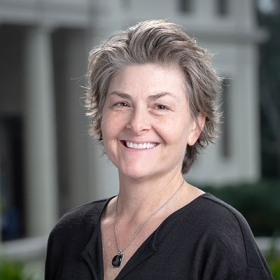
Shana Goffredi’s research interests concern beneficial symbiotic partnerships between bacteria and invertebrates.
Read her Oxy Story profile
Research . Courses . Publications
Summary of Research Interests
Prof. Shana Goffredi is the current Chair of the Biology Department. Her research focuses on the cooperative interactions between invertebrates and bacteria that have significantly contributed to biodiversity on our planet by generating new forms (ex. animal organs and tissues, microbial structures), new physiologies, and even new evolutionary lineages. She explores the molecular ecology and biochemistry of symbiotic systems, and how the environment influences their functioning. Shana teaches Zoology, Microbial Diversity, and Microbial Symbiosis, and was the recipient of the 2014 Linda and Tod White Teaching Prize and the 2023 Graham L. Sterling Memorial Award for distinguished teaching, service, and professional achievement.
Dr. Goffredi’s funding has come from the National Science Foundation, and she has published in journals such as Frontiers in Microbiology, Environmental Microbiology and Science. Her B.S. is in Biology/Marine Science from the Univ. of San Diego and her Ph.D. is in Ecology, Evolution, and Marine Biology from UC Santa Barbara.
Courses
General Zoology (Bio115).
An introduction to the diversity, comparative anatomy, physiology, and ecology of animals. Emphasis is placed on taxonomy, adaptations to the environment, and the evolutionary relationships between animal phyla. Together we build an understanding of animal life on this planet. Students learn to appreciate specific features in animal architecture, trends in the evolution of body design that are shared among animal groups, and the general making of animal diversity. Students gain the knowledge and curiosity to recognize that different animals are adapted to different circumstances with unique capabilities.
Microbial Diversity (Bio325).
An introduction to the world of microbes, including viruses, archaea, and bacteria, and their role in shaping and sustaining life on Earth. Emphasis will be placed on structure, metabolism, physiological and biochemical adaptations to unusual environments, phylogenetic analysis, biotechnology, microbial ecology and biological interactions, including plant and animal symbioses. Students will develop an appreciation for the ubiquity and necessity of microbes and will no longer consider experiences with disease as solely significant. Rather, students will be able to discuss the ways in which microbes, through their enormous metabolic and genetic diversity, make our planet inhabitable. In the lab, students will consider and examine microbial growth and function and will select familiar environments from which to investigate microbial life.
Microbial Symbiosis (Bio350).
Symbioses are intimate associations involving two or more species. Symbiotic associations are widespread in nature and we can expect to find them in every type of ecological niche. This course will cover the diversity of symbiotic interactions that exist between both microbes and fungi and various eukaryotic hosts, including plants, animals, and protists, as well as other microorganisms. Topics will range from molecular to ecological, including the specific molecular communication between partners, the evolution of unusual host structures, novel physiological and biochemical capabilities, and the unique ecological advantages that many symbioses confer. This course will also include writing, presenting, and reviewing of published work on various symbioses.
Publications (2019-2024)
(*) indicates Oxy undergraduates
Siehl, R*, Vyhnal, K* and SK Goffredi. (2024) Friendly Fungi: Tropical Insect Families Form Partnerships with Intracellular Fungi Related to Pathogens. iScience 27, 110674. DOI: 10.1016/j.isci.2024.110674.
Lizarraga A*, Appy R and SK Goffredi. (2024) Life cycle and development of the marine leech Branchellion lobata (Hirudinea: Piscicolidae), from round stingrays, Urobatis halleri, from southern California. Scientific Reports. 14:18108. DOI: 10.1038/s41598-024-69078-z.
García-Lozano M, Henzler C, Porras M, Pons I, Berasategui A, Lanz C, Budde H, Oguchi K, Matsuura Y, Pauchet Y, Goffredi S, Fukatsu T, Windsor D, Salem H (2024). Paleocene origin of a streamlined digestive symbiosis in leaf beetles. Current Biology, 34:1-14. DOI: 10.1016/j.cub.2024.01.070
Goffredi SK, Panossian B, Brzechffa C*, Field N*, King C, Moggioli G, Rouse GW, Martín-Durán JM, Henry. (2023). A dynamic epibiont community associated with the bone-eating polychaete genus Osedax. mBio. 14(4), e03140-22. DOI: 10.1101/2022.11.14.516544.
Moggioli G, Panossian B, Sun Y, Thiel D, Martín-Zamora F, Tran M, Clifford A, Goffredi S, etc. (2023) Distinct genomic routes underlie transitions to specialised symbiotic lifestyles in deep-sea annelid worms. Nature Communications. 14, 2814. DOI: 10.1038/s41467-023-38521-6.
Rouse GW, Goffredi SK (2023). Osedax (Siboglinidae: Annelida) utilizes shark teeth for nutrition. Journal of the Marine Biological Association of the United Kingdom 103:1-6. DOI: 10.1017/S0025315423000243.
Goffredi SK, Appy R, Burreson W. (2023). Pterobdella occidentalis n. sp. for P. abditovesiculata (Moore, 1952) Williams & Burreson 2006 from the staghorn sculpin, Leptocottus armatus, longjaw mudsucker, Gillichthys mirabilis, and other fishes in the Eastern Pacific. Journal of Parasitology. 109(2) 135–144
Goffredi SK, Hildreth R*, deRogatis J.*, Appy R. (2023). Vampire Vibrios: Persistent, internal associations with blood-feeding marine invertebrates. Frontiers in Microbiology.13. DOI: 10.3389/fmicb.2022.1113237.
Azofeifa-Solano JC, Pereira OS, Cowell EJ, Cordes E, Levin LA, Goffredi S, Cortés J. (2022). Sexual dimorphism in the methane seep-dwelling Costa Rican yeti crab Kiwa puravida (Decapoda: Anomura: Kiwaidae). Front. Mar. Sci. 9:1051590. DOI: 10.3389/fmars.2022.1051590.
Goffredi, S.K., C. Motooka*, D.A. Fike, L.C. Gusmão, E. Tilic, G.W. Rouse, and E. Rodríguez (2021). Mixotrophic chemosynthesis in a deep-sea anemone from hydrothermal vents in the Pescadero Basin, Gulf of California. BMC Biology 19(8). DOI: 10.1186/s12915-020-00921-1. See also Behind the Paper (https://go.nature.com/3lZUAUy).
Brzechffa*, C. and S.K. Goffredi (2021). Contrasting Influences on Bacterial Symbiont Specificity by Co-Occurring Deep-Sea Mussels and Tubeworms. Environmental Microbiology Reports.13(2): 104-111. DOI: 10.1111/1758-2229.12909.
Goffredi, S.K., E. Tilic, S.W. Mullin, K.S. Dawson, A. Keller, R.W. Lee, F. Wu, L.A. Levin, G.W. Rouse, E.E. Cordes, V.J. Orphan. (2020). Methanotrophic bacterial symbionts fuel dense populations of deep-sea feather duster worms (Sabellida, Annelida) and extend the spatial influence of methane seepage. Science Advances 6:14, eaay8562.
Appy, R.G., S. Goffredi, B. Pernet and C. Latino. (2019). Experimental transmission of Rhinebothrium urobatidium (Cestoda: Rhinebothriidea) from the round stingray (Urobatis halleri: Myliobatiformes) to first and second intermediate hosts. Bull. Southern California Acad. Sci. 118 (3) 1-19. https://doi.org/10.3160/0038-3872-118.3.139
